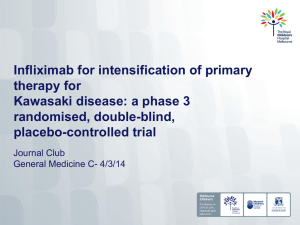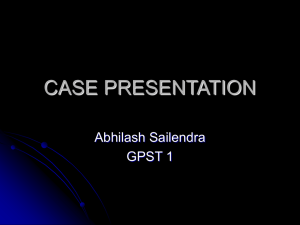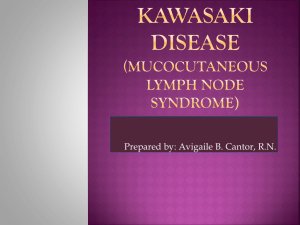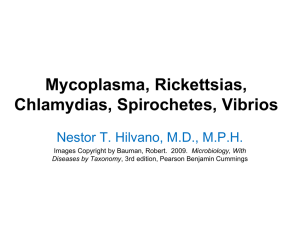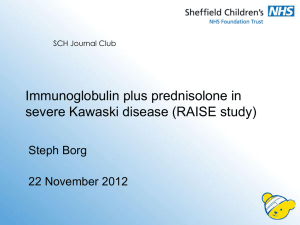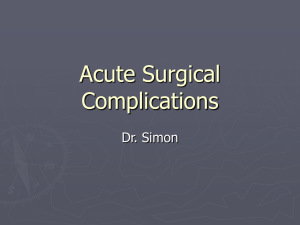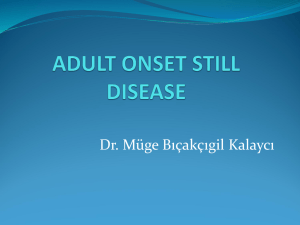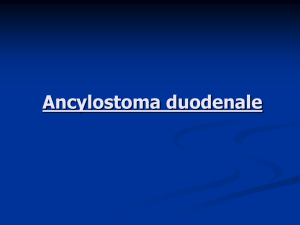Kawasaki Disease
advertisement
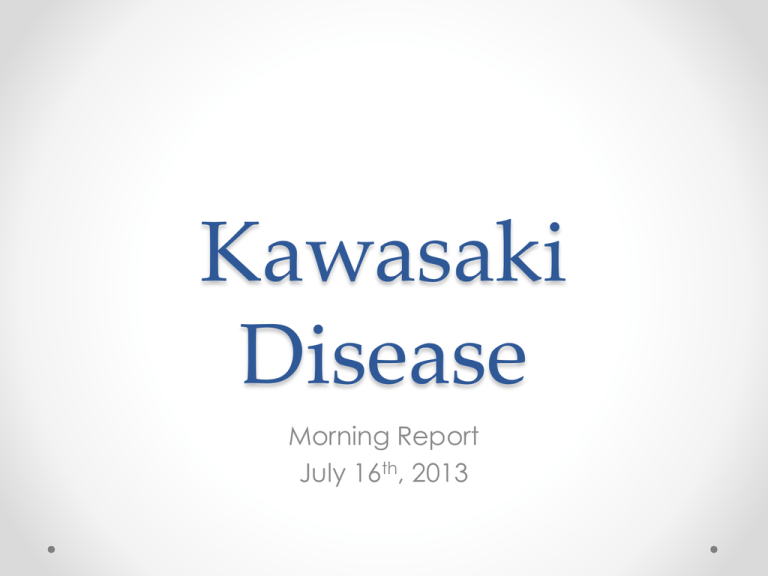
Kawasaki Disease Morning Report July 16th, 2013 Epidemiology • Previously known as mucocutaneous lymph node syndrome • Incidence is greatest in children in East Asia or are of Asian ancestry • Boys more commonly affected than girls • 80-90% of cases in children < 5 yo • Most countries noted increase in cases since early 2000s • Risk factors for poor coronary artery outcomes: o Young age, especially < 6 months o Asian and Pacific Islander race o Hispanic ethnicity Pathogenesis • Unknown! • Infectious? o Seasonal peaks occurred in US and Japan w/ increased incidence in localized areaspossible transmissable vector o Toxin-mediated? Rash can resemble erythroderma similar to TSS or SSSS and IVIG could work by binding toxin • Infection-triggered Inflammation o Many patients w/ KD have documented concomitant infections o Infectious agents could trigger an inflammatory cascade Clinical Manifestations • Diagnosis requires fever > 5 days and at least 4 of the following features: Conjunctivitis Rash Adenopathy Strawberry Tongue Hands/Feet and Burn Clinical Manifestations • Fever o Must be present ≥ 5 days o Most consistent manifestation o Minimally responsive to anti-pyretics o Remains > 38.5 during most of illness Clinical Manifestations • Conjunctivitis o Bilateral non-exudative o Present in >90% of patients o Mainly bulbar injection which spares the limbus o Can be associated w/ photophobia o Typically begins within days of the onset of fever o Anterior uveitis may also be seen on slit lamp exam Clinical Manifesations • Rash o Usually appears within 5 days of fever onset o Often starts as desquamation in perineal area and evolves into a diffuse, erythematous maculopapular rash o Morbilliform and targetoid rashes can also occur o Vesicular/bullous lesions are rare Clinical Manifestations •Adenopathy o Unilateral o Located in anterior cervical chain o Non-fluctuant and non-tender o Diameter should be > 1.5 cm o Cervical lymph node enlargement is least consistent feature Clinical Manifestations • Strawberry Tongue (Mucositis) o Cracked, red lips o Strawberry tongue (sloughing of filiform papillae and denuding of inflamed tissue) o Discrete oral lesions are NOT seen Clinical Manifestations • Hand/Feet Changes o Indurated edema of the dorsum of their hands and feet o Diffuse erythema of palms and soles o Characteristic periungual peeling from fingers and toes begins 2-3 weeks after the onset of fever o Generally the last manifestation to appear Other Manifestations • Arthritis o Up to 25% of patients o Large joints primarily involved • GI (61%) o o o o Diarrhea Vomiting Abdominal Pain Hydrops of the gallbladder • Irritability (50%) o Likely due to meningeal inflammation • Cough or Rhinorrhea (35%) Lab Findings • • • • • • • • • Elevated Neutrophil count w/ bandemia Elevated ESR and CRP Anemia (normocytic, normochromic) Hypoalbuminemia Thrombocytosis (after the 1st week of illness) Sterile pyuria Elevated serum transaminases (40%) Abnormal plasma lipids Pleocytosis of CSF • Echo: evaluate for coronary aneurysms, decreased LV functioning, pericardial effusions Management • Echo o Obtained at diagnosis, 1-2 weeks later, and 6 weeks post-discharge • IVIG o 2g/kg o Ideally, given within first 7 days of illness, and by day 10 (from 1st day of fever) o 15% will have persistent fever after 1st doseresistant to IVIG • Controversial, but most are given another dose after day 10 if persistent fever • Aspirin o High dose (80-100 mg/kg/d): Anti-inflammatory, given until afebrile x 48h o Low dose (3-5mg/kg/d): Anti-thrombotic, given until echo results are normal after 6 weeks Prognosis • Relates entirely to extent of cardiac involvement • If IVIG given in time, incidence of coronary artery lesions is 5% o Aneurysms can regress to normal lumen diameter, but endothelial function is still impaired in these segments o Stenoses can developincreased risk of myocardial ischemia • Most children do well after single dose of IVIG • Mortality is < 0.5% o Highest risk is in the first year after onset of illness because of acute MI in patients with giant aneurysms

